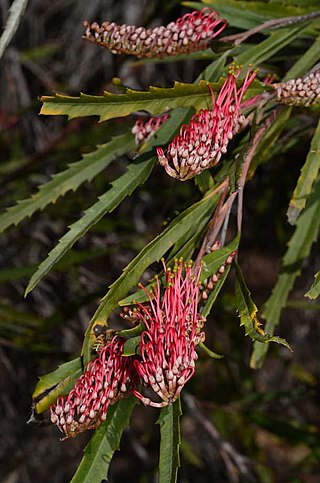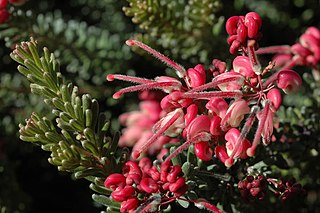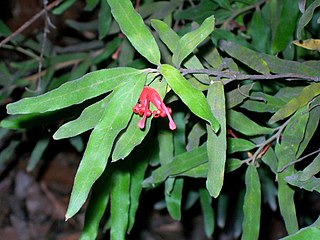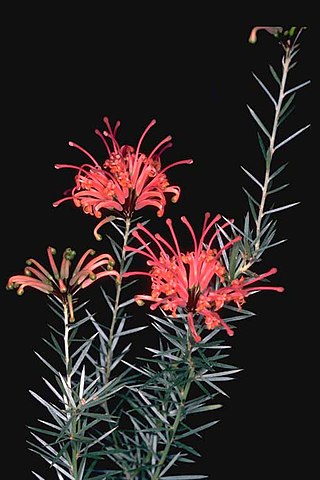
Grevillea longifolia, commonly known as fern-leaf spider flower, is a species of flowering plant in the family Proteaceae and is endemic to the Sydney Basin in New South Wales. It is an erect to spreading shrub with narrowly egg-shaped to almost linear leaves, and toothbrush-like groups of pinkish-fawn flowers with a pink to red style. It is fairly readily grown in gardens.

Grevillea rosmarinifolia, commonly known as rosemary grevillea, is a species of flowering plant in the family Proteaceae and is endemic to south-eastern continental Australia and naturalised in other parts of the country. It is usually an erect, compact to open shrub with linear, narrowly elliptic or narrowly oblong leaves with the edges rolled under, and loose clusters of pink to red flowers.

Grevillea petrophiloides, commonly known as pink pokers, rock grevillea or poker grevillea, is a species of flowering plant in the family Proteaceae and is endemic to the south-west of Western Australia. It is an erect shrub with divided leaves, the lobes mostly linear, and cylindrical clusters of usually pink to reddish pink and bluish-grey flowers.

Grevillea lanigera, commonly known as woolly grevillea, is a species of flowering plant in the family Proteaceae and is endemic to south-eastern continental Australia. It is a spreading shrub with narrowly oblong to more or less linear leaves and clusters of pink to red, and cream-coloured flowers.

Grevillea sericea, commonly known as the pink spider flower, is a species of flowering plant in the family Proteaceae and is endemic to New South Wales. It is a shrub with elliptic to lance-shaped leaves with the narrower end towards the base, and clusters of usually pink flowers arranged on one side of a flowering rachis.

Grevillea oldei is a species of flowering plant in the family Proteaceae and is endemic to a small area of eastern New South Wales. It is a diffuse shrub with narrowly egg-shaped to more or less triangular leaves, and red flowers.

Grevillea guthrieana, commonly known as Guthrie's grevillea, is a species of flowering plant in the family Proteaceae and is endemic to New South Wales. It is a spreading shrub with oblong leaves and clusters of two to six green and maroon flowers.

Grevillea rivularis, commonly known as Carrington Falls grevillea, is a species of flowering plant in the family Proteaceae and is endemic to New South Wales. It is a dense, spreading shrub with divided leaves with more or less linear, sharply-pointed lobes, and clusters of cream-coloured flowers that turn pink or grey as they age.

Grevillea mollis, commonly known as soft grevillea, is a species of flowering plant in the family Proteaceae and is endemic to a restricted area of north-eastern New South Wales. It is an open, spreading shrub with oblong to elliptic leaves and loose clusters of bright scarlet red flowers.

Lomatia myricoides, commonly known as the river lomatia, is a shrub native to New South Wales and Victoria in southeastern Australia.
Grevillea scortechinii, commonly known as the black grevillea, is a shrub which is endemic to Queensland and New South Wales in Australia.

Grevillea sessilis is a species of flowering plant in the family Proteaceae and is endemic to north-eastern Queensland. It is a shrub or small tree with divided leaves and cylindrical clusters of white flowers with a creamy-white or greenish yellow style.

Grevillea exposita is a species of flowering plant in the family Proteaceae and is endemic to the south-west of Western Australia. It is a dense, spreading shrub with mostly oblong to narrowly elliptic leaves and clusters of bright red and white flowers.

Grevillea kennedyana, also known as flame spider-flower, is a species of flowering plant in the family Proteaceae and is endemic to a restricted area of inland eastern Australia. It is an erect shrub with many branches, usually linear leaves and erect clusters of rich red flowers.
Grevillea rhizomatosa, commonly known as Gibraltar grevillea, is a species of flowering plant in the family Proteaceae and is endemic to a restricted area of north-eastern New South Wales. It is a spreading, bushy shrub with egg-shaped to almost round leaves and small clusters of green and pinkish-red flowers.

Grevillea quadricauda, commonly known as four-tailed grevillea, is a species of flowering plant in the family Proteaceae and is endemic to eastern Australia. It is an erect, dense, bushy shrub with narrowly egg-shaped to elliptic leaves and small, loose clusters of green and pinkish-red flowers.

Grevillea masonii, commonly known as Mason's grevillea, is a species of flowering plant in the family Proteaceae and is endemic to a restricted area of New South Wales. It is a low-growing shrub with egg-shaped to elliptic leaves, and red and green flowers with a green style.
Grevillea roycei is a species of flowering plant in the family Proteaceae and is endemic to the south-west of Western Australia. It is an open, erect to spreading shrub with divided leaves, the lobes linear to tapering, and more or less spherical clusters of cream-coloured and yellow flowers with a white style.

Grevillea rudis is a species of flowering plant in the family Proteaceae and is endemic to the south-west of Western Australia. It is a loose, spreading to erect shrub with divided leaves, the end lobes more or less triangular to oblong and sharply pointed, and more or less cylindrical clusters of cream-coloured flowers, the style turning pink as it ages.

Grevillea scabra, commonly known as the rough-leaved grevillea, is a species of flowering plant in the family Proteaceae and is endemic to the south-west of Western Australia. It is a low, open shrub with clusters of narrowly elliptic to more or less linear leaves and small clusters of white to cream-coloured flowers.


















